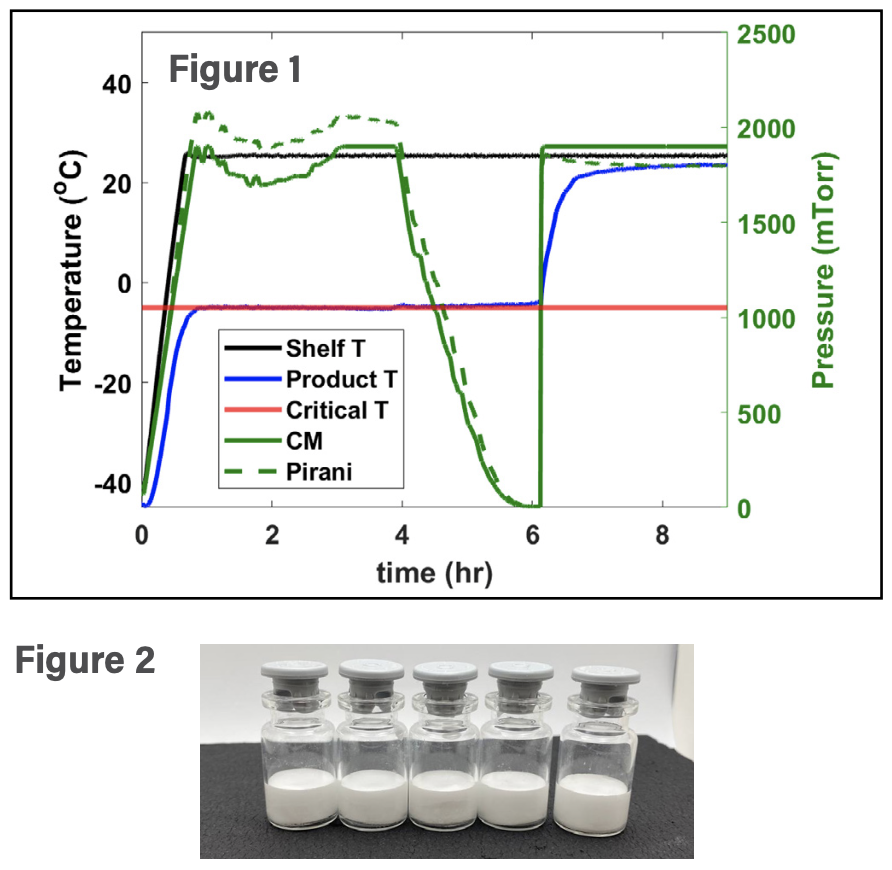LyoHUB Past Projects
Model predictive control for the primary drying stage of lyophilizationInvestigator: Petr Kazarin (Purdue/AAE) Lyophilization, commonly referred to as freeze-drying, is a widely used method of preserving biomaterials and pharmaceuticals. The longest and most time-consuming stage of lyophilization, primary drying, sublimates ice from the frozen product to produce a dry and stable product. The dynamics of the drying process are complex, making it difficult to control and optimize while being essential for the output's quality and stability. In this work, we investigate the application of nonlinear model predictive control (MPC) in the first drying stage of lyophilization. The MPC control approach uses a mathematical model of the primary drying process to forecast future behavior and optimize the operation (significantly reducing the primary drying time while maintaining product quality). In this paper, we demonstrate how MPC improves the efficiency of the lyophilization process.
|
Radio-frequency-assisted freeze drying of pharmaceutical products: Influence of applied power on drying timeInvestigators: Dimitri Peroulis (Purdue/ECE), Ahmad Darwish (Purdue/ECE) Because of the rising demand for lyophilized injectable medicines over
|
In-situ vial strain measurements during freeze/thaw processes using amorphous excipientInvestigators: Ian Flynn (Purdue/LyoHUB), Drew Strongrich (Purdue/LyoHUB) The effects of mechanical stresses developed between a frozen formulation and glass vial during freezing and thawing operations are not well understood. In many cases, the interfacial forces can become significant, leading to catastrophic failure of the primary packaging (i.e. breakage). To investigate these effects, an experimental campaign using wireless strain gauges was carried out as part of the Purdue’s Chemical Engineering Professional Master’s Program. The sensors measured strain output using foil gauges and vial wall temperature via a resistance temperature detector (RTD). A 6R vial illustrating the location of the RTD and strain gauge is provided in Figure 1. The study focused on freeze/thaw cycles with different concentrations of amorphous excipients, specifically sucrose and trehalose.
|
Characterization of heat transfer through gas and its impact on vial heat transfer during primary and secondary dryingsInvestigators: Vivek Narsimhan (Purdue/ChemE), Kyu Yoon (Purdue/ChemE) The importance of heat transfer during the secondary drying stage cannot be overstated as it greatly influences the temperature profile of the material, which has a direct impact on the removal of bound water. Historically, it has been assumed that the heat transfer coefficient (Kv) during secondary drying is the same as during primary drying and that most of the heat goes towards drying the material. However, recent studies have challenged these assumptions and have suggested that Kv should be a function of the moisture content in the chamber, implying that it should be different in primary and secondary drying.
|
Excipient databaseInvestigators: Ashwani Agarwal (Purdue/AAE), Drew Strongrich (Purdue/LyoHUB) Excipients are inactive substances that play an important role in the formulation and development of drugs. The study and analysis of excipients used in lyophilized drugs is important as it helps in ensuring the quality and efficacy of such drugs. However, to review the usage of excipients in lyophilized drugs there was a lack of a consolidated resource that documented all inactive ingredients (excipients) used in every FDA-approved lyophilized drug. To address this gap, we created a unique and comprehensive database of all FDA- approved lyophilized drugs from 1954 to 2022.
|
Measuring lyophilized porous structures with Micro-CT scanningInvestigators: Vivek Narsimhan (Purdue/ChemE), Isaac Wheeler (Purdue/ChemE) The mass transfer resistance Rp is an essential parameter in models of the primary drying step of lyophilization. This value quantifies how much dried material obstructs the flow of water vapor, and is known to depend on many factors (including formulation, freezing conditions, and drying conditions). By investigating the porous structure of lyophilized material, we hope to improve estimates and understanding of Rp.
|
Lyophilization cycle design and optimization of aqueous co-solvent formulations using residual gas analysisLipid Nano Particle (LNP) encapsulated mRNA vaccines are generally unstable at room temperature and require storage under cryogenic temperature prior to administration. Although freezing is simple, proven, and effective, the cold chain dependency of these substances is unsustainable in the long term. Preparation of LNP-based vaccines typically requires high concentrations of ethanol to prevent agglomeration prior to encapsulation.
|










